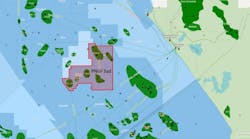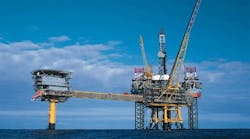Do carbon sinks absorb fossil fuel output?
Environmental policy makers are operating ahead of reasonable scientific knowledge and setting policies of dubious value. More importantly, they are attempting to "solve a problem" (global warming) by imposing penalties (taxes) and controls (usage of fossil fuels) on producers and consumers without sufficient knowledge.New evidence places the global warming/ carbon dioxide debate in a different light. Published in a recent issue of Science, a study by the Carbon Modeling Consortium at Princeton University presents evidence of a major "carbon-sink" in North America.
Up to 1.7 petagrams (1.7 x 1015) of carbon is absorbed in North America, according to the study. This is enough to overcome the carbon dioxide (CO2) produced by burning fossil fuels in both the United States and Canada. Other studies dispute the results of this work.
The Princeton study also points out the limited number of monitoring stations world wide, the complexities of the carbon cycle, and the need to assess the effect of plant growth on carbon absorption.
The article quotes Steven Crookshank of the American Petroleum Institute: "(the study) calls into question the scientific basis on which we're making these (global warming) decisions, when we still don't know if the United States is even emitting any carbon in the net." Much more work is needed before governments can understand the atmosphere, much less control it.
- Cooling costs: The Energy Information Agency has concluded that compliance with the Kyoto accords will cost the average US household US$355 to US$1,740 annually. Prices for gasoline would increase US$0.14 to US$0.66 per gallon while natural gas prices would rise 25% to 147%. Such an increase would cost the gross national product between US$60 and US$387 billion. The estimates are based on greenhouse gas reductions of 7% from 1990 figures. The estimates are significantly higher than those projected by the Clinton Administration.
- OPEC view: OPEC does not want to lower its current production levels. The Saudis favor extending the present levels for an additional six months beyond the current agreement.
Money: The root of all deals
Since Saudia Arabia's Crown Prince Abdullah ibn Abdulaziz's October meeting with several large oil companies to explore a "new relationship," most of the companies are examining possibilities. Texaco indicated that it will offer a proposal before January.The Saudis have oil while the oil companies have investment capital. Saudi Arabia and the other OPEC members have been losing market share to non-OPEC producers in large measure because oil investment diversified away from their operations when Middle Eastern oil resources were nationalized in the 1950s. Complete nationalization of Saudi Aramco occurred in the late 1970s.
It is only natural that the oil companies would prefer to pump oil under their control rather than purchase oil from the competition (OPEC producers). The recent low oil price environment has pressed the issue. If Saudi and other OPEC nations want access to oil company capital, they will have to offer a win-win deal that generates a profit for all involved. The successful Texaco/Saudi STAR refining/marketing joint venture may be a model for future relationships.
Venezuelan vampires and Russian pumpers
Two nations are coping with the global financial collapse in different ways:- Venezuela is bleeding its national patrimony from Petroleos de Venezuela (PDVSA) to help overcome the global financial pressures. The government has demanded almost US$1.4 billion in additional dividends from the company. This adds up to almost US$3.25 billion extracted from PDVSA's operating funds this year and imperils many of its joint venture partnerships. It will be some time before the effect on Lake Maracaibo redevelopment projects becomes clear.
- Russia is expanding foreign currency earnings. Crude oil exports during the first six months of 1998 are reportedly 10% higher than for the same period in 1997. Sales of crude were over 437 million bbl, with total 1998 sales expected to reach 810 million bbl of crude. Russia has abandoned earlier pledges to reduce oil sales to help raise global oil prices.
Hidden crude problem for price recovery
Crude oil analysts continue to chase a high side 300 million bbl discrepancy in the supply/demand balance. In a recent Wall Street Journal article, the Center for Global Energy Studies provided a possible explanation - 612 million bbl of independent storage scattered around the world. Most of the storage is in OECD countries where it is counted. However, much is uncounted and outside the reach of the International Energy Agency (IEA). There is also temporary crude storage capacity occurring in tankers. The IEA stands by its numbers. They consider the barrels real and in storage waiting to come to market.Brazil contracts awards begin
Petrobras awarded the first contracts for partnership. YPF was tapped to explore Block BCE-2, a 907 sq km tract north of the Campos basin in 100-400 meter water depths. YPF leads a six-company consortium that includes Santa Fe, Sotep, Norbay, Petroserv, and Wiser. The consortium will invest US$20 million to collect 1,800 km of 2D seismic and 288 sq km of 3D seismic. Up to three wells are planned.Coastal, Unocal, and Ipiranga won two blocks in partnership with Petrobras. They will develop Block BCAM-2 and Block BAS-97 in the Camamu Basin. The exploration period for all partnerships is limited to three years compared to the six-year lease terms being offered by ANP, Brazil's new Petroleum Regulatory Agency.
Australia seeks more aquatory
Australia has completed its data collection process to establish its aquatory claim. The nation will formally apply to the United Nations for an increase in its offshore exclusive economic zone (EEZ) to 12 million sq km. The current EEZ is 7.8 million sq km.Copyright 1998 Oil & Gas Journal. All Rights Reserved.




